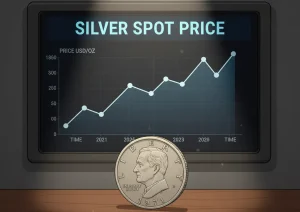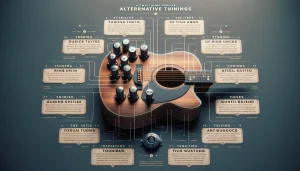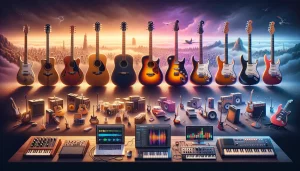Understanding the Different Types of Guitars
Acoustic, Electric, and Everything In Between
If guitars were personalities, they’d each have their quirks, styles, and voices. Choosing the right one begins with understanding their variety. Let’s start with the soulful acoustic guitar. It’s the storyteller’s sidekick—perfect for campfire songs and heartfelt ballads. Whether it’s a dreadnought with its booming sound or a smaller parlor guitar ideal for intimate melodies, acoustic guitars thrive on simplicity: no plugs, just pure resonance.
Then there’s the electric guitar, the rockstar of the group. Powered by pickups and amps, it can wail, crunch, or shimmer depending on your mood. From the crisp tones of a Fender Stratocaster to the growl of a Gibson Les Paul, these guitars are perfect for genres like blues, metal, and jazz.
What about a middle ground? The semi-hollow guitar. It combines the warmth of an acoustic with the electric’s versatility, making it a favorite for indie and vintage-inspired players.
The Special Flavors of Guitars
And if you want something unique, consider:
- Classical guitars – With nylon strings, they’re softer on the fingers and ideal for Latin, flamenco, or classical music.
- Bass guitars – These deep-voiced giants set the groove, holding every band together like glue.
- 12-string guitars – Twice the strings mean twice the sparkle, creating lush, chorus-like sounds.
Each guitar has its own story. Which one will match yours?
Identifying Your Preferred Playing Style

Discover Your Musical Soul
Choosing the right guitar starts with one essential question: what kind of music makes your heart race? Picture this—are you sitting under dim lights, strumming a soulful acoustic tune, or shredding a face-melting solo on a stage drenched in neon? Your guitar should be an extension of your personality.
If you’re all about mellow vibes and storytelling, an acoustic guitar might be your soulmate. Dreaming of jazzy improvisations or bluesy licks? A hollow-body electric could be your muse. But if your playlist is stacked with rock anthems, metal riffs, or indie bangers, a solid-body electric screams your name.
- Acoustic lovers: Warm, natural tones that wrap around vocals like a hug.
- Blues players: Smooth bends and gritty slides deserve a responsive electric setup.
- Shred heads: Fast necks and versatile pickups for blistering solos.
Think About Your Go-To Techniques
Do you live for intricate fingerpicking patterns, or do you feel alive when you dive into power chords? Imagine how it feels to hold the instrument. Fingerstyle demands a delicate touch—find a guitar with wide string spacing. Strummers thrive with durable builds, while lead players need speed-friendly necks.
Your playing style isn’t just “how” you play—it’s “who” you are as a musician.
Considering Guitar Features and Specifications

Dialing in on the Perfect Fit
Finding the right guitar often feels like choosing a dance partner. It’s not just about looks—it’s about how it moves with you, how it feels in your hands, and whether it can whisper every note your heart wants to play. When diving into guitar features and specs, let’s talk about the things that can’t be ignored.
First, consider the neck. Is it slim and speedy for quick solos, or chunkier for a solid grip during soulful rhythm playing? If you’re the type who loves intricate fingerpicking, a wider fretboard might feel like home. And then there’s body shape—are you drawn to the sleek contours of a Stratocaster, or do the aggressive lines of an Explorer call your name?
Don’t forget the weight! A heavy guitar can anchor your performance but may tire you out; lightweight models are easier to manage for long gigs. When in doubt, trust your gut—and your hands.
Setting a Budget and Exploring Options

Pinning Down Your Price Range
Let’s be honest, buying a guitar can feel like falling down a rabbit hole—there are shiny options everywhere, but your pocket has limits! Before splurging on that dreamy vintage Fender or a custom-built Taylor, pause and ask yourself: what’s realistic for you?
Here’s the deal: the price of guitars can swing wildly. You’ll find dependable acoustic models starting at around $150, while high-end electric guitars can climb past $5,000 (yes, you read that right!). But don’t panic—you don’t have to spend a fortune to start shredding. For beginners or players upgrading from their first guitar, the **$300-$700 sweet spot** often delivers incredible quality without breaking the bank.
- Got cash to spare? High-end guitars bring premium materials and jaw-dropping craftsmanship, but tread carefully—looks aren’t everything.
- Tight budget? Consider pre-loved instruments. A secondhand gem can pack serious sound for half the price!
Exploring Beyond the Obvious
Once your budget’s set, unleash your curiosity! Don’t limit yourself to “the usual suspects” like big retail chains. Hunt in quirky local music shops—they’re treasure chests filled with unique guitars, each carrying its own story. Better yet, try different brands. Sure, Gibson and Ibanez are icons, but **brands like PRS or Guild** might just surprise you with their tone and value.
Treat this journey like dating—don’t settle at first sight. Swipe right (or pluck a few strings) until you’ve explored all the possibilities!
Testing and Finalizing Your Choice

Bring the Guitar to Life in Your Hands
It’s go-time! No specs sheet or online video can replace the visceral joy of holding a guitar and feeling its energy. Testing isn’t just a step—it’s where the imaginary riffs in your head finally come to life. Here’s your mission: let the guitar speak to you.
Spend some time in the store or at home with the instrument. Play your go-to riff, even if it’s just “Smoke on the Water” for the hundredth time. Does the neck glide under your fingers, or does it feel like wrestling a broomstick? Strum big open chords—how do they resonate? Are the notes full-bodied and rich, or do they fall flat like yesterday’s soda?
- Check the action (string height). Does it feel comfortable, or are your fingertips screaming for mercy?
- Listen closely for fret buzz. A subtle, uninvited buzz can be a deal-breaker.
- Test it plugged and unplugged. A guitar should still sing even without an amp.
This is the part where emotion matters as much as logic. If you stumble into a moment where you can’t stop smiling while playing, take note—this could be *the one*.
The Final Gut Check Before You Commit
Before swiping your card, take one last pause. Ask yourself: does this guitar match not just your playing style but also your personality? Think about how it feels *strapped around your shoulder*. Does it inspire confidence, or will you second-guess it later? Your connection with your guitar is personal—it’s more of a love story than a transaction.
If you’re torn between two, don’t rush. Sleep on it, revisit, or even record yourself playing each guitar to compare the sound. Sometimes, the choice becomes clearer after stepping away. Above all else, trust your instincts—they’re often louder than any amp.






